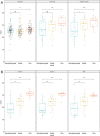Performances, feasibility and acceptability of nasopharyngeal swab, saliva and oral-self sampling swab for the detection of severe acute respiratory syndrome coronavirus 2
- PMID: 33987804
- PMCID: PMC8118679
- DOI: 10.1007/s10096-021-04269-4
Performances, feasibility and acceptability of nasopharyngeal swab, saliva and oral-self sampling swab for the detection of severe acute respiratory syndrome coronavirus 2
Abstract
Molecular diagnosis on nasopharyngeal swabs (NPS) is the current standard for COVID-19 diagnosis, but saliva may be an alternative specimen to facilitate access to diagnosis. We compared analytic performances, feasibility and acceptability of NPS, saliva, and oral-self sampling swab for the detection of severe acute respiratory syndrome coronavirus 2 (SARS-CoV-2). A prospective, multicenter study was conducted in military hospitals in France among adult outpatients attending COVID-19 diagnosis centers or hospitalized patients. For each patient, all samples were obtained and analyzed simultaneously with RT-PCR or transcription-mediated amplification method. Clinical signs, feasibility, and acceptability for each type of sample were collected. A total of 1220 patients were included, corresponding to 1205 NPS and saliva and 771 OS. Compared to NPS, the sensitivity, specificity, and kappa coefficient for tests performed on saliva were 87.8% (95% CI 83.3-92.3), 97.1% (95% CI 96.1-98.1), and 0.84 (95% CI 0.80-0.88). Analytical performances were better in symptomatic patients. Ct values were significantly lower in NPS than saliva. For OS, sensitivity was estimated to be 61.1% (95% CI 52.7-69.4) and Kappa coefficient to be 0.69 (95% CI 0.62-0.76). OS was the technique preferred by the patients (44.3%) before saliva (42.4%) and NPS (13.4%). Instructions were perceived as simple by patients (> 90%) for saliva and OS. Finally, the painful nature was estimated to be 0.9 for OS, on a scale from 0 to 10, and to be 5.3 for NPS. Performances of OS are not sufficient. Saliva is an acceptable alternative to NPS for symptomatic patient but the process required additional steps to fluidize the sample.
Keywords: COVID-19; Nasopharyngeal swab; Oral-self sampling; SARS-CoV-2; Saliva.
© 2021. The Author(s), under exclusive licence to Springer-Verlag GmbH Germany, part of Springer Nature.
Conflict of interest statement
The authors declare that there is no conflict of interest.
Figures
References
-
- World Health Organization (2020) Laboratory testing for coronavirus disease 2019 (COVID-19) in suspected human cases: interim guidance, 2 March 2020. World Health Organization. Available at: https://apps.who.int/iris/handle/10665/331329
-
- Centers for Disease Control and Prevention (2020) Interim Guidelines for Collecting, Handling, and Testing Clinical Specimens from Persons for Coronavirus Disease 2019 (COVID-19), 14 April 2020. Available at: https://www.cdc.gov/coronavirus/2019-ncov/lab/guidelines-clinical-specim...
-
- Fiche de gestion des prélèvements biologiques d’un patient suspect ou confirmé de la COVID-19, Version 6, Septembre 2020. Available at: https://www.sfm-microbiologie.org/wp-content/uploads/2020/09/Fiche-COVID...
Publication types
MeSH terms
LinkOut - more resources
Full Text Sources
Other Literature Sources
Medical
Miscellaneous


